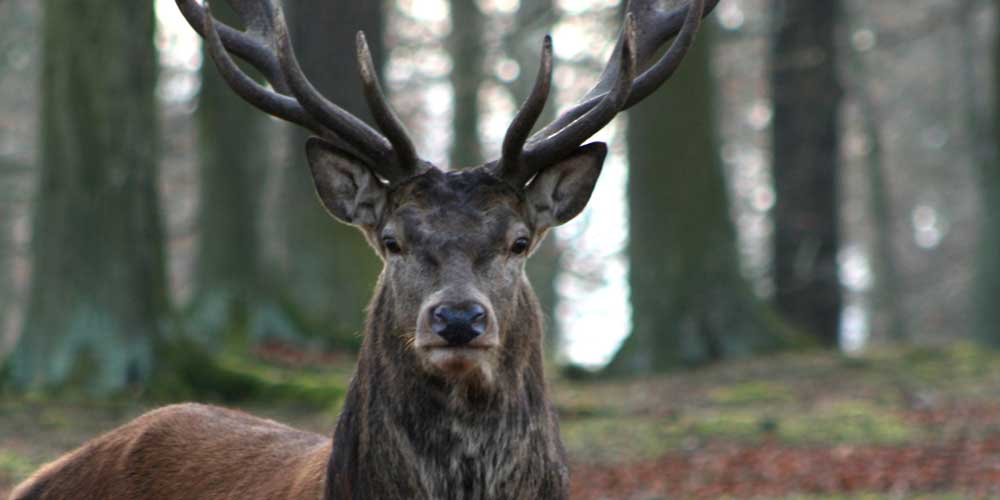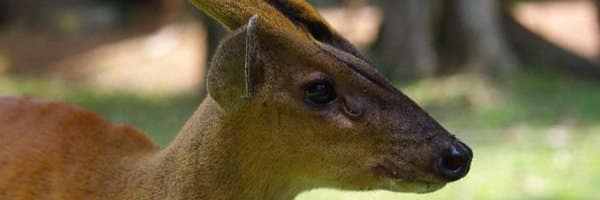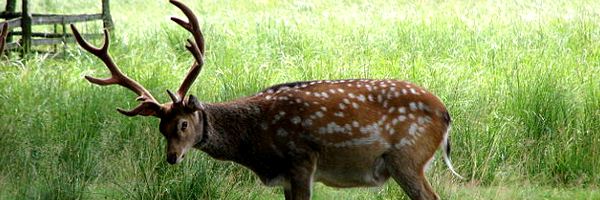Red Deer – Cervus elaphus
The Red Deer feature a gorgeous coat that is any shade of red. They often have a darker color to them that can almost seem brown in many regions. As the year moves along though and winter sets in the coloring will be more of a gray. This is why some people often mistake them for other species of deer in the winter months. Their appearance changes in order to give them a chance to blend into their surroundings all year long.
The antlers of the males are amazing, and a key point as to why people want to hunt for them. They usually have at least 6 points on them but often as many as 15 can be present. The more dominant the male is the more points he will feature. The antlers span outward and so they can cover quite a bit of distance.
They are among the largest of deer species out there. A full grown male can be up from 350 to 530 pounds in size. The females are about 260-370 pounds. The males can be about 4.2 feet tall with the females about 3.2 feet tall.
Red Deer Anatomy
The body of the Red Deer is very bulky but also very powerful. They have strength in their bodies that you wouldn’t imagine by looking at them. In spite of their large size, they are able to move very quickly when they need to. They definitely get lots of attention due to the mass size of the antlers that grow on the males.
Red Deer Evolution
Fossil records indicate that the Red Deer has been around for more than 12 million years. What has taken place in order for them to survive isn’t fully known. It is believed based upon the remains that they were several times larger back then than they are today. The ability to blend into their surroundings is believed to be a characteristic of evolution that occurred as they got smaller and were more vulnerable to predators.
The Red Deer has a long history that goes very far back in Britain. They were once allowed to roam freely so that the royalty of Britain could hunt for them. They were magnificent creatures even then and so there is a story that still remains untold about their evolution process.
Red Deer Behavior
While Red Deer do form herds, the size of them can be very different. A large herd, with as many as 400 individuals, is an indication that the environment is able to offer them plenty of food and shelter. A small herd can mean that a larger one branched off in order to be able to meet the needs of the members.
The larger herds tend to be out in the open and this is an indicator that they feel safer in groups. When they have others with them they are less likely to be bothered by predators. They also get the socialization that they need. The males tend to be alone out there once they are mature though so the herds mainly have the females present.
Red Deer Distribution
Both the woodland areas and the plains offer the Red Deer a great place to be able to live. They spend lots of time moving around looking for food. They do have their own established home range. The span of it can be several miles but for many of these herds the area is getting smaller and smaller. Humans continue to push into their areas along the edges, leaving less space for them.
Red Deer Feeding Habits
There are quite a bit of food resources out there for the Red Deer. They include mat grass, moss, and lichen. It is very hard for them to find enough food in most areas though during the winter months. That is when they will feed on just about any type of plant life that they are able to in order to survive. Leaves and twigs are often what they survive on through the winter months.
Red Deer Reproduction
The male Red Deer are going to be fighting for the ability to mate with the females. Nature has set it up so that only the most dominant are able to do so. The antlers are the weapons that the males will use to challenge each other. You will notice the neck is fuller during mating too. This happens because they have more hormones being produced in the glands located there.
The females are ready to mate when they are 16 months old. The males are also ready to mate when they are 16 months old. However, they will have to wait to be one year old before they have the strength to win the battles with other males so that they can mate.
Those battles can last for a very long time before one of them gives up. Usually there isn’t any real damage to either party involved. Yet it can be exhausting to take part in them. Generally the males will start to become more aggressive in September and it can last for several months. The rut allows the dominant males to gather many females that only he will mate with. Each of them will enter their cycle for mating within a few days of each other. Therefore he has his work cut out for him.
He will leave the females after he has mated with each of them. He will have lost lots of weight during the mating season. Therefore he must venture out to eat as much food as he can before the difficult winter sets in. If he isn’t successful there is a good chance he won’t survive to the following spring.
It will be just about 8 months before the young fawn arrives. It is almost always going to be just one of them. The mother is going to take it into hiding for a few weeks so that both can become stronger. The young are very obedient and they will usually stay put when their mother has to leave to find her own food.
These deer live 10 to 15 years in the wild but they are known to live more than 20 years in captivity. A large portion of the young fawns don’t make it to their first year due to predators. After that period though, they are often considered too large and too dangerous for most predators to bother them.
Red Deer Predators
The wolf is believed to be the biggest predator of the Red Deer in the wild. However, there have been many areas where the wolf has had a huge decrease in population. Due to the reintroduction of them to various areas, it has affected the number of Red Deer as well. Some people aren’t very happy about this but experts believe it will balance out populations and that there is room for both to live in certain habitats.
Humans seem to love to hunt the Red Deer due to the size of it. These animals can offer lots of meat and it takes very good. The bonuses of such hunts include being able to taxidermy such a large animal. Others only want to keep the antlers which are very large and that they proudly display on the wall of their home.







